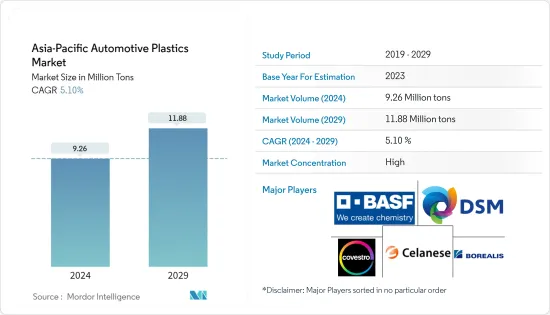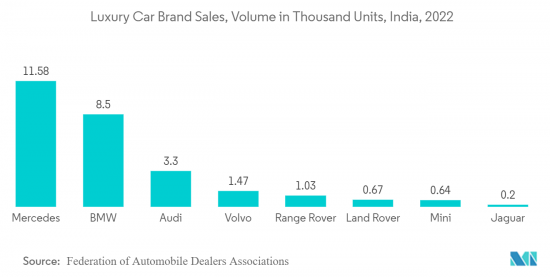PUBLISHER: Mordor Intelligence | PRODUCT CODE: 1408876

PUBLISHER: Mordor Intelligence | PRODUCT CODE: 1408876
Asia-Pacific Automotive Plastics - Market Share Analysis, Industry Trends & Statistics, Growth Forecasts 2024 - 2029

The Asia-Pacific Automotive Plastics Market size is estimated at 9.26 Million tons in 2024, and is expected to reach 11.88 Million tons by 2029, growing at a CAGR of 5.10% during the forecast period (2024-2029).
The COVID-19 pandemic has affected the automotive plastics market negatively. Due to the lockdown and restrictions, the supply of raw materials was disrupted leading to a negative impact on the manufacturing activities in the region. However, the conditions started recovering in 2021, restoring the market's growth trajectory.
Key Highlights
- The increasing demand for lightweight materials and increasing polypropylene applications in vehicles are the major factors driving the growth of the market studied.
- However, challenges associated with plastic recycling are likely to restrain the growth of the studied market.
- Nevertheless, an increase in market penetration of electric vehicles is likely to create lucrative growth opportunities for the studied market.
- China represents the largest market over the forecast period due to the increasing demand for electric vehicles.
Asia-Pacific Automotive Plastics Market Trends
Interior Segment to Dominate the Market
- Plastics are the primary material used in vehicles, which helps to make the vehicles lightweight and fuel efficient. It holds the properties to keep vehicles safe and comfortable for the passengers and allows producers to make their vehicles more appealing to consumers.
- The average automotive vehicle has 30,000 parts and about one-third of these parts are made from plastic materials. Plastics are used for making parts like carburetors, fenders, dashboards, handles, engine covers, interior wall panels, seating, truck bed liners, cable insulation, and others.
- Major luxury car manufacturers such as BMW, Audi, Mercedes, Porsche, and Rolls Royce, all use plastic materials, primarily in the interior of their cars whether it be for small details like the button on the doors or center console or in some cases, a sizable portion of the dashboard and gauges.
- According to BMW, China recorded the largest sales market for BMW in the fiscal year of 2022. China accounted for around 33.1% of Rolls-Royce, BMW, and MINI cumulative sales. Chinese customers bought almost 793,500 such vehicles in the 2022 fiscal year.
- According to the Federation of Automobile Dealers Associations, in the financial year 2022, Mercedes was the leading luxury car brand in terms of sales with around 11.6 thousand units sold in India. It was followed by BMW and Audi, with 8.5 thousand and 3.3 thousand units sold respectively.
- Thus, all the aforementioned factors are likely to increase the demand for the automotive plastics market in the Asia-Pacific region over the forecast period.

China to Dominate the Market
- China is the world's biggest automobile market in terms of both production and sales. Thus, with the rising number of vehicles, the demand for automotive plastics is also increasing.
- According to the Organisation Internationale des Constructeurs d'Automobiles (OICA), the total vehicle production accounted for 27 million units in 2022, registering an increase of 3.4% compared to the last year.
- Further, according to the China Association of Automobile Manufacturers (CAAM), the total production of passenger cars and commercial vehicles in 2022 reached 2.38 million units and 318 thousand units, respectively.
- Furthermore, with government subsidies, Chinese electric vehicles are emerging as price leaders in Southeast Asian nations where Japanese companies like Toyota Motor Corp. and Isuzu Motors Ltd. have long controlled most of the automotive market.
- For more than a decade, China has backed the production of smaller, affordable EVs and their most expensive component, batteries. In 2022, China accounted for more than half of EVs sold globally.
- In China, sales of new EVs increased by 82% in 2022 compared to the previous year. The country accounted for 59% of global EV sales last year, cementing its position as the world's largest electric vehicles market.
- According to the International Energy Agency (IEA), China sold nearly six million electric cars in the Asia-Pacific region alone in 2022.
- Therefore, the rising automotive production in the region is likely to positively influence the market studied over the forecasted period.
Asia-Pacific Automotive Plastics Industry Overview
The Asia-Pacific automotive plastics market is consolidated in nature. The major players in the market (not in any particular order) include BASF SE, Borealis AG, Celanese Corporation, Covestro AG, and DSM, among others.
Additional Benefits:
- The market estimate (ME) sheet in Excel format
- 3 months of analyst support
TABLE OF CONTENTS
1 INTRODUCTION
- 1.1 Study Assumptions
- 1.2 Scope of the Study
2 RESEARCH METHODOLOGY
3 EXECUTIVE SUMMARY
4 MARKET DYNAMICS
- 4.1 Drivers
- 4.1.1 Increasing Demand for Lightweight Materials
- 4.1.2 Increasing Polypropylene Application In Vehicles
- 4.1.3 Other Drivers
- 4.2 Restraints
- 4.2.1 Challenges Associated with Plastic Recycling
- 4.2.2 Other Restraints
- 4.3 Industry Value Chain Analysis
- 4.4 Porter's Five Forces Analysis
- 4.4.1 Bargaining Power of Suppliers
- 4.4.2 Bargaining Power of Buyers
- 4.4.3 Threat of New Entrants
- 4.4.4 Threat of Substitute Products and Services
- 4.4.5 Degree of Competition
5 MARKET SEGMENTATION (Market Size in Volume)
- 5.1 Material
- 5.1.1 Polypropylene (PP)
- 5.1.2 Polyurethane (PU)
- 5.1.3 Polyvinyl Chloride (PVC)
- 5.1.4 Polyethylene (PE)
- 5.1.5 Acrylonitrile Butadiene Styrene (ABS)
- 5.1.6 Polyamides (PA)
- 5.1.7 Polycarbonate (PC)
- 5.1.8 Other Materials (ASA, PET, PBT, PMMA, etc.)
- 5.2 Application
- 5.2.1 Exterior
- 5.2.2 Interior
- 5.2.3 Under Bonnet
- 5.2.4 Other Applications (Instrument Panel, Powertrain, Door Systems, etc.)
- 5.3 Vehicle Type
- 5.3.1 Conventional/Traditional Vehicles
- 5.3.2 Electric Vehicles
- 5.4 Geography
- 5.4.1 China
- 5.4.2 India
- 5.4.3 Japan
- 5.4.4 South Korea
- 5.4.5 ASEAN Countries
- 5.4.6 Rest of Asia-Pacific
6 COMPETITIVE LANDSCAPE
- 6.1 Mergers and Acquisitions, Joint Ventures, Collaborations, and Agreements
- 6.2 Market Share (%)**/Ranking Analysis
- 6.3 Strategies Adopted by Leading Players
- 6.4 Company Profiles
- 6.4.1 Arkema
- 6.4.2 BASF SE
- 6.4.3 Borealis AG
- 6.4.4 Celanese Corporation
- 6.4.5 Covestro AG
- 6.4.6 DSM
- 6.4.7 Evonik Industries AG
- 6.4.8 Exxon Mobil Corporation
- 6.4.9 LG Chem
- 6.4.10 LyondellBasell Industries Holdings B.V.
- 6.4.11 SABIC
- 6.4.12 Solvay
7 MARKET OPPORTUNITIES AND FUTURE TRENDS
- 7.1 Growing Electric Vehicle Penetration
- 7.2 Other Opportunities




